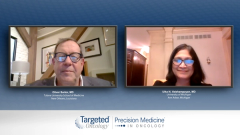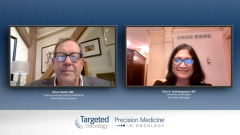
Other PSMA-Targeted Radioligands in Development
A review of the PSMA-targeted radioligand therapies that are currently in development.
Episodes in this series

Ulka N. Vaishampayan, MD: What about other PSMA [prostate-specific membrane antigen]-targeted radioligands? Can you comment on those?
Oliver Sartor, MD: Sure. This is a very rapidly burgeoning area. First, let me mention PSMA617 lutetium-177, which I have mentioned several times. That is going to be moving up in the treatment paradigm. There are trial designs in the pre-taxane setting. That can be in the post–abiraterone-enzalutamide setting, similar to the PROfound trial design but without the taxanes. Then there are trials bringing it all the way up front that NRG [Oncology], Alliance [Oncology], and Novartis are working together on to be able to look at metastatic castrate-sensitive prostate cancer.
We talk about PSMA617 lutetium-177 and those coming up, but there are also other small molecules. There’s 1 called PSMA(int) [intracellular domain of PSMA] that is being developed by a little company called POINT Biopharma. They’re also going to be looking at phase 3 trials, and they’ll be looking at these concepts in the pre-taxane metastatic CRPC [castration-resistant prostate cancer] setting, again with selecting some patients. Then we have novel things like some of the copper isotopes, copper-67 being developed by some small companies that are trying to move those forward. Also very early in clinical development are some of the small PSMA molecules that are going to be binding to albumin to be able to prolong the half-life of the PSMA617 and diminish the renal excretion.
I didn’t mention: 1 of the fears we have is that there will be renal toxicity because of the renal excretion. Albumin-targeted molecules manage to diminish that renal excretion and may improve the therapeutic ratio between tumor and kidney.
Those are the small molecules. We also have big molecules. These are antibodies. There’s 1 called J591 that is in development in multiple settings. There is another that doesn’t have a name but was developed to bind PSMA as a dimer. It’s a very good antibody. That’s not being developed with lutetium but rather thorium-227.
Let me back up just a second. I mainly mentioned these lutetium-177s, but there are also iodine-based molecules. There’s a small molecule called 1095 with iodine-131 attached that’s a beta emitter. In addition, I mentioned the copper-67 as an alternative isotope. Lutetium has a different beta. Then we have the alphas. Alphas are 2 protons, 2 neutrons like radium, but radium is really difficult to chelate. We have actinium-225 and thorium-227 that are moving forward and maybe even radium-212.
There’s a lot of activity in these areas. There are multiple small molecules, multiple big molecules, and multiple isotopes. It’s a very active area of investigation.
Ulka N. Vaishampayan, MD: That is exciting, especially with the wave of new radioligand therapies under investigation. If you think about it, it does make sense to move these therapies earlier. As you get into the later stages of disease, prostate cancer does tend to get undifferentiated neuroendocrine features, so it typically won’t express PSMA. That may be the concern if you wait until the more advanced stages.
Oliver Sartor, MD: I agree, Ulka. It’s interesting. Drug development favors the late-stage patient because you get the end point sooner. On the other hand, it may not be optimal to wait until the end of the line. It may be better to treat these patients up front. Of course, there’s so much more to learn, not only about tumor heterogeneity but also the underlying genetics. Some alterations like BRCA may actually be radiosensitizers. Of course, we may have radioresistance for others.
We have a lot more to learn about the influence of genotypic biomarkers with the phenotypic biomarkers, the outcomes, and the therapeutic landscape. Of course, everything is always evolving. No matter what you think, it’s going to be different tomorrow.
Ulka N. Vaishampayan, MD: Every treatment brings its own resistance with it. That’s true.
Oliver Sartor, MD: But it’s fun. That’s what keeps us going.
This transcript has been edited for clarity.








































